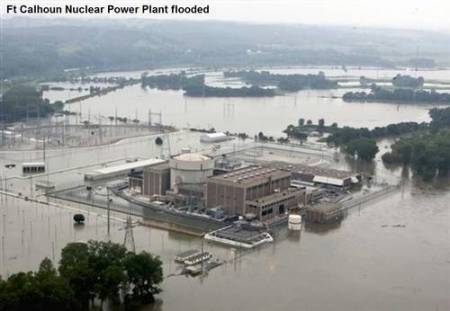
Why is there a Media Blackout on Nuclear Incident at Fort Calhoun in Nebraska?
Patrick Henningsen
On June 7th, there was a fire reported at Fort Calhoun. The official story is that the fire was in an electrical switchgear room at the plant. The apparently facility lost power to a pump that cools the spent fuel rod pool, allegedly for a duration of approximately 90 minutes.
FORT CALHOUN NUKE SITE: does it pose a public risk?
The following sequence of events is documented on the Omaha Public Power District’s own website, stating among other things, that here was no such imminent danger with the Fort Calhoun Station spent-fuel pool, and that due to a fire in an electrical switchgear room at FCS on the morning of June 7, the plant temporarily lost power to a pump that cools the spent-fuel pool.
In addition to the flooding that has occurred on the banks of the Missouri River at Fort Calhoun, the Cooper Nuclear Facility in Brownville, Nebraska may also be threatened by the rising flood waters.
As was declared at Fort Calhoun on June 7th, another “Notification of Unusual Event” was declared at Cooper Nuclear Station on June 20th. This notification was issued because the Missouri River’s water level reached an alarming 42.5 feet. Apparently, Cooper Station is advising that it is unable to discharge sludge into the Missouri River due to flooding, and therefore “overtopped” its sludge pond.
Not surprisingly, and completely ignored by the Mainstream Media, these two nuclear power facilities in Nebraska were designated temporary restricted NO FLY ZONES by the FAA in early June. The FAA restrictions were reportedly down to “hazards” and were ‘effectively immediately’, and ‘until further notice’. Yet, according to the NRC, there’s no cause for the public to panic.
A news report from local NBC 6 on the Ft. Calhoun Power Plant and large areas of farm land flooded by the Missouri River, interviews a local farmer worried about the levees, “We need the Corps-Army Corps of Engineers–to do more. The Corps needs to tell us what to do and where to go. This is not mother nature, this is man-made.” Nearby town Council Bluffs has already implemented its own three tier warning system should residents be prepared to leave the area quickly.
On June 6, 2011, the Federal Aviation Administration put into effect ‘temporary flying restrictions’–until further notice–over the Fort Calhoun Nuclear Power Plant in Blaine, Nebraska.
To date, no one can confirm whether or not the Ft Calhoun Nuclear incident is at a Level 4 emergency on a US regulatory scale. A Level 4 emergency would constitute an “actual or imminent substantial core damage or melting of reactor fuel with the potential for loss of containment integrity.” According to the seven-level International Nuclear and Radiological Event Scale, a Level 4 incident requires at least one death, which has not occurred according to available reports.
Nuclear engineer Arnie Gundersen explains how cooling pumps must operate continuously, even years after a plant is shut down.
According a recent report on the People’sVoice website, The Ft. Calhoun plant — which stores its fuel rods at ground level according to Tom Burnett – is now partly submerged and Missouri River levels are expected to rise further before the summer if finished, local reports in and around the Fort Calhoun Nuclear Plant suggest that the waters are expected to rise at least 5 more feet.
Burnett states, “Ft. Calhoun is the designated spent fuel storage facility for the entire state of Nebraska…and maybe for more than one state. Calhoun stores its spent fuel in ground-level pools which are underwater anyway – but they are open at the top. When the Missouri river pours in there, it’s going to make Fukushima look like an X-Ray.”
The People’s Voice’s report explains how Ft Calhoun and Fukushima share some of the very same high-risk factors:
“In 2010, Nebraska stored 840 metric tons of the highly radioactive spent fuel rods, reports the Nuclear Energy Institute. That’s one-tenth of what Illinois stores (8,440 MT), and less than Louisiana (1,210) and Minnesota (1,160). But it’s more than other flood-threatened states like Missouri (650) and Iowa (420).”
Conventional wisdom about what makes for a safe location regarding nuclear power facilities was turned on its head this year following Japan’s Fukushima disaster following the earthquake and tsunami which ravaged the region and triggered one of the planets worst-ever nuclear meltdowns.
As was the critical event in Fukushima, in Ft Calhoun circulating water is required at all times to keep the new fuel and more importantly the spent radioactive material cool. The Nebraska facility houses around 600,000 – 800,000 pounds of spent fuel that must be constantly cooled to prevent it from starting to boil, so the reported 90 minute gap in service should raise alarm bells.
TV and radio journalist Tom Hartmann explores some of these arguments here:
Nebraska’s nuclear plant’s similarities to Japan’s Fukushima, both were store houses for years of spent nuclear fuel rods.
RISK: Levees in and around Omaha were not designed for 3 months of water.
“Corn is a key ingredient in ethanol gasoline, feeds America’s livestock and is found in many food products including soft drinks and cereal. Prices will undoubtedly increase steadily at the grocery store, gas pump and butcher shop throughout the summer as Midwest flooding continues along the Missouri River basin. Not only are farmers losing their homes, land and fields — ultimately their bank accounts will also suffer this season.”
June 23, 2011

